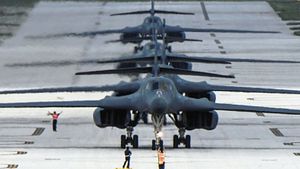The U.S. Air Force (USAF) only has six fully mission-capable B-1B Lancer strategic bombers, according to the head of U.S. Strategic Command (STRATCOM), USAF General John Hyten.
Of the USAF’s 61 B-1Bs, 39 are grounded for inspections with an additional 15 in depot maintenance. “We have B-1B bombers; this is the workhorse of the Air Force today,” Hyten told U.S. Senate Armed Services Committee members during a hearing to become vice chairman of the Joint Chiefs of Staff.
“Right now, of all of our B-1 bombers, we have six of them that are fully mission capable: five split between Ellsworth Air Force Base [South Dakota] and Dyess Air Force Base [Texas], one is a test aircraft, 15 B-1s are in depot,” Hyten was quoted as saying during the hearing by Military.com. “The remaining 39 of 44 B-1s at Ellsworth and at Dyess are down for a variety of discrepancies and inspections.”
The supersonic B-1 constitutes the backbone of the USAF’s conventional long-range bomber force. The aircraft is capable of carrying a bombload of 75,000 pounds (34,000 kilograms)—the largest payload of both guided and unguided weapons in the USAF’s inventory.
The USAF last deployed four B-1B Lancer strategic bombers to Andersen Air Force Base on Guam in the Western Pacific in February 2017 for a rotational deployment. This was preceded by the dispatch of B-1Bs and over 300 airmen from the 34th Expeditionary Bomb Squadron of the 28th Bomb Wing from Ellsworth Air Force Base, South Dakota to Guam in August 2016. It was the first deployment of B-1B bombers to Guam in over a decade.
There are currently no B-1B Lancers stationed in Indo-Pacific region.
The B-1B test aircraft in past years has been used for testing the new Long-Range Anti-Ship Missile (LRASM), a next-generation anti-ship missile with standoff capabilities and a derivative of the Joint Air-to-Surface Standoff Missile – Extended Range (JASSM-ER), a long-range cruise missile with an estimated range of up 1,000 kilometers.
The reason for the B-1B fleet’s low readiness rate is due to wear and tear as a result of an overextended deployment schedule paired with the age of the airframe — the B-1B entered service in the 1980s.
“We were just beating the heck out of them, deploying them, deploying them,” Hyten said during the testimony. “We had to pull back a little and get after fixing those issues. The depots can do that if they have stable funding.”
The entire B-1B fleet was also grounded for weeks in June 2018 and March 2019 due to ejection seat issues. In May 2018, a B-1B was forced to conduct an emergency landing at a Texas airport when a fire broke out in its wing.
The USAF’s long-range strike capabilities “may be placed at increased risk by aging structural problems with the B-1,” the House Armed Services seapower and projection forces subcommittee said in the U.S. House of Representative’s version of the fiscal 2020 defense policy bill in June.
Air Force Global Strike Command told Task & Purpose last week that seven B-1Bs were fully mission-capable.

































